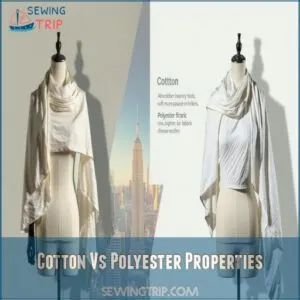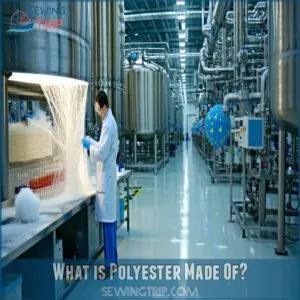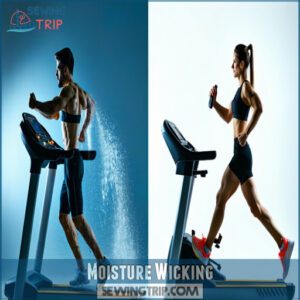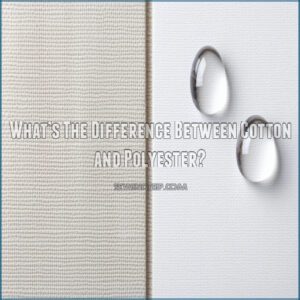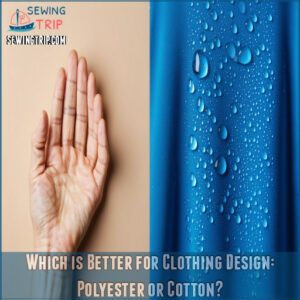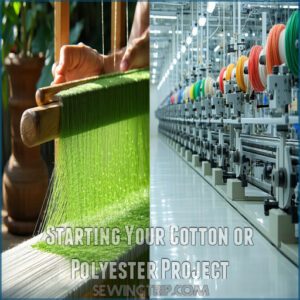This site is supported by our readers. We may earn a commission, at no cost to you, if you purchase through links.
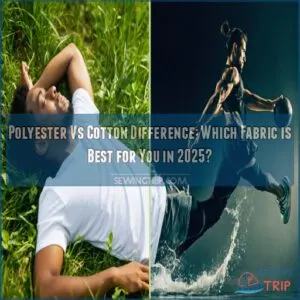 When comparing the polyester vs cotton difference, you’ll find each fabric’s unique personality shines through.
When comparing the polyester vs cotton difference, you’ll find each fabric’s unique personality shines through.
Cotton’s soft, breathable nature keeps you cool and comfortable, absorbing moisture like a champ.
Polyester, the athletic cousin, repels water and dries faster, making it perfect for workout gear.
While cotton feels gentle on sensitive skin, polyester offers unbeatable durability and strength.
Sustainability-wise, cotton wins with its biodegradable charm, though recycled polyester is stepping up its eco-friendly game.
Your fabric choice depends on your needs: want comfort? Grab cotton.
Need performance? Polyester’s your go-to.
Blend them together, and you’ll discover a textile superhero that combines the best of both worlds.
Table Of Contents
- Key Takeaways
- Cotton Vs Polyester Properties
- How is Cotton Processed?
- What is Polyester Made Of?
- Polyester Vs Cotton: Pros and Cons
- What’s The Difference Between Cotton and Polyester?
- Which is Better for Clothing Design: Polyester or Cotton?
- Starting Your Cotton or Polyester Project
- Frequently Asked Questions (FAQs)
- Conclusion
Key Takeaways
- You’ll find cotton shines for comfort and breathability, while polyester dominates in durability and performance wear – so choose based on your specific clothing or project needs.
- Performance matters: polyester excels at moisture-wicking and quick-drying, making it perfect for activewear, whereas cotton offers superior softness and natural feel for everyday clothing.
- Sustainability plays a crucial role in your fabric choice – cotton’s biodegradable nature gives it an eco-friendly edge, though recycled polyester is stepping up its environmental game.
- Blending cotton and polyester can create a textile "superhero" that combines the best properties of both fabrics, giving you versatility, comfort, and strength in one material.
Cotton Vs Polyester Properties
When comparing cotton and polyester, it’s all about understanding how each fabric performs in key areas like absorbency, strength, and comfort.
By knowing their unique properties, you’ll make smarter choices for your wardrobe or projects, especially considering comfort.
Absorbency
Absorbency plays a huge role in fabric choice, and cotton takes the crown here.
Its natural fibers soak up moisture like a sponge, keeping you dry and comfy.
Polyester? Not so much—it’s hydrophobic and repels water.
Understanding the fabric properties comparison is essential for making informed decisions about which fabric to use.
| Feature | Cotton | Polyester | Winner |
|---|---|---|---|
| Water Absorption | High | Low | Cotton |
| Moisture Retention | Excellent | Minimal | Cotton |
| Drying Speed | Slow | Fast | Polyester |
| Breathability Comparison | Superior | Moderate | Cotton |
Cotton’s absorbency levels make it perfect for hot weather or sportswear, while polyester’s moisture-wicking helps in activewear.
Strength
In the case of strength, polyester outshines cotton in most durability tests.
Its high tensile strength, excellent fiber durability, and superior material resistance make it a champion under fabric tension.
Cotton, though naturally strong, improves when wet but doesn’t match polyester’s resilience.
Need a quick comparison? Check this out:
| Factor | Cotton | Polyester |
|---|---|---|
| Tensile Test | Strong (wet) | Very strong |
| Yarn Strength | Moderate | High |
| Tear Resistance | Less durable | More durable |
| Material Lifespan | Shorter | Longer |
So, is cotton stronger or polyester? For long-lasting durability, polyester benefits win hands down.
Sustainability
Sustainability is a game-changer when picking fabrics.
Cotton, a biodegradable material, breaks down naturally, while polyester lingers in landfills.
Want to go greener? Organic cotton supports eco-friendly farming, and recycled polyester reduces waste.
Understanding natural fiber benefits is essential for making informed decisions.
Here’s a quick breakdown:
| Material | Eco Friendly? | Biodegradable? |
|---|---|---|
| Organic Cotton | Yes | Yes |
| Recycled Polyester | Yes | No |
| Regular Polyester | No | No |
Choosing green textiles means embracing sustainable fashion and lowering your environmental impact.
Comfort
Ever wondered why your clothing feels like a second skin or a sauna?
Understanding fabric comfort goes beyond touch—it’s about how materials breathe, stretch, and adapt to your body.
Cotton whispers softness, while polyester stands ready for action.
Let’s break down the comfort game with this revealing comparison:
| Fabric | Softness | Breathability | Skin Feel |
|---|---|---|---|
| Cotton | High | Excellent | Gentle |
| Poly | Moderate | Limited | Smooth |
| Blend | Balance | Good | Versatile |
Your comfort, your choice, is influenced by the breathability and skin feel of the fabric.
How is Cotton Processed?
Let’s unravel the fascinating journey of cotton processing, where nature’s fluffy treasure transforms into your favorite fabric.
From fields bursting with potential to textile masterpieces, cotton’s path is nothing short of remarkable.
Here’s how cotton becomes fabric magic:
- Harvest those seed-laden bolls with precision
- Separate fibers through the ginning process
- Transform raw fibers into strong, flexible yarn
- Apply strategic bleaching for softness
- Weave threads into breathable, durable fabric
Imagine each cotton fiber as a tiny storyteller, carrying traditions of textile craftsmanship.
The process combines agricultural skill with industrial precision, turning humble plant material into clothing that breathes, comforts, and connects us to natural fibers.
Your favorite cotton shirt? It’s a tribute to this intricate, age-old transformation.
What is Polyester Made Of?
Want to know the science behind your favorite polyester shirt?
Polyester isn’t grown – it’s engineered from petrochemical magic.
Material scientists transform purified terephthalic acid and ethylene glycol into continuous synthetic fibers through a precise polyester production process.
By melting these chemical compounds and extruding them through microscopic holes, manufacturers create strong, resilient fibers that define modern fabric technology.
The chemical composition gives polyester its unique characteristics – durability meets artificial innovation.
Unlike natural cotton, this synthetic fiber originates from oil and gas derivatives, raising interesting questions about environmental impact.
Emerging plant-based polyester alternatives hint at a more sustainable future, bridging material science with ecological consciousness.
Your everyday clothing? It’s a reflection of human ingenuity.
Polyester Vs Cotton: Pros and Cons
Are you tired of choosing between comfort and durability when selecting fabric for your clothing or home textiles?
This guide will break down the pros and cons of polyester and cotton, helping you make an informed decision that suits your specific needs in 2025.
Durability
Crush durability challenges with polyester’s superhero-like performance.
Its remarkable fiber endurance makes it the go-to fabric for demanding lifestyles.
Polyester’s exceptional durable fabric properties contribute substantially to its popularity in clothing manufacturing.
| Property | Polyester | Cotton |
|---|---|---|
| Tear Strength | High | Moderate |
| Wear Resistance | Excellent | Limited |
| Color Retention | Superior | Moderate |
From activewear to everyday clothing, polyester’s material strength guarantees your garments withstand intense wear, keeping you looking sharp without constant replacements.
Allergies and Skin Sensitivity
Ever battled skin irritation from your clothing?
In the case of fabric allergies, cotton emerges as the hero for sensitive skin.
It’s hypoallergenic and breathable, offering a soothing embrace that polyester can’t match.
Polyester might trigger dermatological issues, causing itchy reactions and discomfort due to static electricity and low moisture absorption.
| Fabric Type | Skin Sensitivity |
|---|---|
| Cotton | Hypoallergenic ✓ |
| Polyester | Potential Irritant ✗ |
Choose wisely to keep your skin happy and comfortable, avoiding those pesky allergic reactions that can turn your day from smooth to scratchy in seconds, and opt for sensitive skin friendly materials to ensure a soothing experience.
Moisture Wicking
Sweating through workouts? Your fabric choice matters.
Polyester’s moisture-wicking magic pulls sweat away, keeping you dry and cool.
For a detailed list of options, explore this moisture wicking fabrics list.
Cotton absorbs moisture but leaves you feeling damp and uncomfortable.
| Fabric | Moisture Management | Performance |
|---|---|---|
| Polyester | Excellent | Quick-dry |
| Cotton | Poor | Slow-dry |
Choose wisely: dry comfort or wet discomfort?
What’s The Difference Between Cotton and Polyester?
When you’re exploring the realm of fabrics, understanding cotton and polyester feels like traversing a textile maze.
Here’s a quick roadmap to help you:
- Breathability: Cotton acts like a natural ventilation system, while polyester can feel like a sealed greenhouse.
- Fabric Maintenance: Cotton wrinkles easily and demands more care, polyester stays crisp with minimal effort.
- Environmental Footprint: Cotton biodegrades gracefully, whereas polyester lingers in landfills like an uninvited guest.
- Cost Dynamics: Polyester wins the budget battle, being cheaper to produce, but cotton reigns supreme in comfort.
Mastering these material science insights helps you make smarter textile choices, whether you’re designing clothing or selecting everyday wear.
Understanding the differences between cotton thread vs polyester is vital for selecting the right fabric for your specific needs.
Which is Better for Clothing Design: Polyester or Cotton?
When choosing between polyester and cotton for clothing design, three key factors emerge.
Cotton offers unbeatable softness and breathability, making it a dream for everyday comfort and eco-conscious fashion.
Polyester shines in performance wear, delivering vibrant colors, exceptional durability, and moisture-wicking properties that keep you cool during intense activities.
Textile science reveals that blending these fabrics can harness the best of both worlds – cotton’s natural feel with polyester’s resilience.
Your fabric choice ultimately depends on your specific garment needs, whether you’re crafting activewear, casual clothing, or professional attire.
Understanding the differences between polyester and cotton empowers you to create garments that look great and perform even better.
For superior results, consider exploring polyester clothing design techniques to enhance your creations.
Starting Your Cotton or Polyester Project
Whether you’re dreaming of a cozy sweater or a rugged backpack, your fabric choice can make or break your project.
As you begin your textile journey, consider these key factors:
- Fabric Selection: Match material to project goals
- Material Costs: Budget for quality and performance
- Project Planning: Anticipate fabric behavior and limitations
- Textile Tools: Invest in equipment suited to your chosen fabric
- Color Choices: Explore how different fabrics take dye
Cotton offers breathability and softness, perfect for clothing that feels like a second skin.
Polyester brings durability and wrinkle resistance, ideal for high-performance gear.
Each fabric tells a different story – your job is to choose the right narrator for your creative vision.
Understanding the thread production methods is vital for selecting the best material for your project.
Pro tip: Always test a sample before committing to your entire project.
Frequently Asked Questions (FAQs)
Which is better cotton or polyester?
Worried about fabric performance?
Your ideal choice depends on activity: outdoor gear loves polyester; soft tees crave cotton’s natural feel.
Polyester wins for durability and quick-drying, while cotton offers breathable comfort.
Is polyester healthier than cotton?
You’ll find cotton healthier due to its natural, breathable fibers that prevent skin irritation and bacterial growth.
Polyester’s synthetic material traps moisture and heat, potentially causing discomfort and allergic reactions for sensitive skin, which is why natural fibers are often preferred.
What are the disadvantages of polyester?
Trapped in a synthetic web, you’ll battle polyester’s hidden pitfalls: skin irritation, poor breathability, microplastic shedding, heat retention, and environmental toxins that compromise your comfort and the planet’s health.
Is 50% polyester and 50% cotton better than 100% cotton?
A 50/50 cotton-polyester blend offers balanced comfort and durability.
You’ll enjoy softness from cotton and wrinkle resistance from polyester, making it more versatile than pure cotton for everyday wear and active lifestyles.
What is the difference between polyester and cotton?
You’ll notice polyester’s synthetic, durable nature contrasts with cotton’s natural, breathable softness. Each fabric shines differently: polyester excels in performance wear, while cotton wins for comfort and everyday clothing.
What is the difference between polyester and polycotton?
Like a chameleon blending two colors, polycotton seamlessly merges polyester’s durability with cotton’s comfort.
You’ll enjoy a fabric that’s wrinkle-resistant, soft, and versatile—perfect for clothing that adapts to your active lifestyle.
Why is cotton a water-intensive fabric compared to polyester?
You’ll drain massive water resources growing cotton’s thirsty crops, which require extensive irrigation and processing compared to polyester’s synthetic production that uses substantially less water throughout manufacturing.
Is cotton more expensive than polyester?
In the textile world’s fabric bazaar, cotton’s price tag often shines brighter than polyester’s.
You’ll typically find cotton pricier due to its labor-intensive harvesting, processing, and natural origin compared to the synthetic, mass-produced polyester.
What is the difference between cotton and polycotton?
Polycotton blends polyester and cotton, giving you durability and comfort.
You’ll get wrinkle resistance from polyester and softness from cotton, making it a versatile fabric that adapts to your daily wear and lifestyle needs.
Why is cotton softer than polyester?
You’ll feel cotton’s softness because its natural fibers have soft, organic textures and hollow gaps that expand, creating a plush, breathable fabric different from polyester’s synthetic, smoother polymer structure.
Conclusion
Ultimately, the polyester vs cotton difference boils down to your unique needs.
Like a fabric tailor crafting the perfect garment, you’ll want to match material to purpose.
Whether you’re seeking moisture-wicking performance or breathable comfort, each fabric brings its A-game.
By understanding their strengths, you’ll make smart choices that blend functionality and style.
Your wardrobe isn’t just clothing—it’s a strategic investment in comfort, durability, and personal expression.
- https://barnhardtcotton.net/blog/know-fibers-difference-between-polyester-and-cotton/
- https://www.fibre2fashion.com/industry-article/9157/cotton-vs-polyester-similarities-and-differences
- https://www.organiccottonmart.com/blogs/sustainable-lifestyle/polyester-vs-cotton
- https://www.houseofu.com/en/blog/polyester-vs-cotton-whats-the-difference/
- https://www.mizzenandmain.com/blog/polyester-vs-cotton

